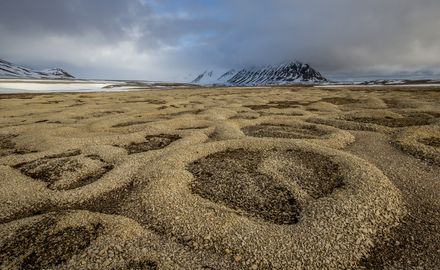Human-made climate change suppresses the next ice age

Landscape shaped by Permafrost dynamics near Spitzbergen. Photo: Alfred-Wegener-Institute/Jaroslav Obu
“Even without man-made climate change we would expect the beginning of a new ice age no earlier than in 50.000 years from now – which makes the Holocene as the present geological epoch an unusually long period in between ice ages,” explains lead author Andrey Ganopolski. “However, our study also shows that relatively moderate additional anthropogenic CO2-emissions from burning oil, coal and gas are already sufficient to postpone the next ice age for another 50.000 years. The bottom line is that we are basically skipping a whole glacial cycle, which is unprecedented. It is mind-boggling that humankind is able to interfere with a mechanism that shaped the world as we know it.”
For the first time, research can explain the onset of the past eight ice ages by quantifying several key factors that preceded the formation of each glacial cycle. “Our results indicate a unique functional relationship between summer insolation and atmospheric CO2 for the beginning of a large-scale ice-sheet growth which does not only explain the past, but also enables us to anticipate future periods when glacial inception might occur again,” Ganopolski says.
Humanity as a geological force
Using an elaborate Earth system model simulating atmosphere, ocean, ice sheets and global carbon cycle at the same time, the scientists analyzed the effects of further human-made CO2-emissions on the ice volume on the Northern Hemisphere.
“Due to the extremely long life-time of anthropogenic CO2 in the atmosphere, past and future emissions have a significant impact on the timing of the next glacial inception,” co-author Ricarda Winkelmann says.
“Our analysis shows that even small additional carbon emissions will most likely affect the evolution of the Northern Hemisphere ice sheets over tens of thousands of years, and moderate future anthropogenic CO2-emissions of 1000 to 1500 Gigatons of Carbon are bound to postpone the next ice age by at least 100.000 years.”
The quest for the drivers of glacial cycles remains one of the most fascinating questions of Earth system analysis and especially paleoclimatology, the study of climate changes throughout the entire history of our planet. Usually, the beginning of a new ice age is marked by periods of very low solar radiation in the summer, like at current times.
However, at present there is no evidence for the beginning of a new ice age: “This is the motivation for our study. Unravelling the mystery of the mechanisms driving past glacial cycles also facilitates our ability to predict the next glacial inception,” Winkelmann says.
“Like no other force on the planet, ice ages have shaped the global environment and thereby determined the development of human civilization. For instance, we owe our fertile soil to the last ice age that also carved out today’s landscapes, leaving glaciers and rivers behind, forming fjords, moraines and lakes.
However, today it is humankind with its emissions from burning fossil fuels that determines the future development of the planet,” co-author and PIK-Director Hans Joachim Schellnhuber says. “This illustrates very clearly that we have long entered a new era, and that in the Anthropocene humanity itself has become a geological force. In fact, an epoch could be ushered in which might be dubbed the Deglacial.”
Article: Ganopolski, A., Winkelmann, R., Schellnhuber, H.J. (2016): Critical insolation-CO2 relation for diagnosing past and future glacial inception. Nature [DOI:10.1038/nature16494]
Weblink to the article once it is published: http://www.nature.com/nature/index.html
For further information please contact:
PIK press office
Phone: +49 331 288 25 07
E-Mail: press@pik-potsdam.de
Twitter: @PIK_Climate
Media Contact
More Information:
http://www.pik-potsdam.deAll latest news from the category: Earth Sciences
Earth Sciences (also referred to as Geosciences), which deals with basic issues surrounding our planet, plays a vital role in the area of energy and raw materials supply.
Earth Sciences comprises subjects such as geology, geography, geological informatics, paleontology, mineralogy, petrography, crystallography, geophysics, geodesy, glaciology, cartography, photogrammetry, meteorology and seismology, early-warning systems, earthquake research and polar research.
Newest articles

First-of-its-kind study uses remote sensing to monitor plastic debris in rivers and lakes
Remote sensing creates a cost-effective solution to monitoring plastic pollution. A first-of-its-kind study from researchers at the University of Minnesota Twin Cities shows how remote sensing can help monitor and…

Laser-based artificial neuron mimics nerve cell functions at lightning speed
With a processing speed a billion times faster than nature, chip-based laser neuron could help advance AI tasks such as pattern recognition and sequence prediction. Researchers have developed a laser-based…

Optimising the processing of plastic waste
Just one look in the yellow bin reveals a colourful jumble of different types of plastic. However, the purer and more uniform plastic waste is, the easier it is to…



